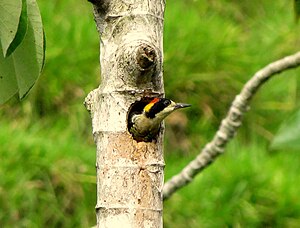Ornamental woodpecker
| Ornamental woodpecker | ||||||||||||
|---|---|---|---|---|---|---|---|---|---|---|---|---|

Ornamental woodpecker ( Melanerpes pulcher ) |
||||||||||||
| Systematics | ||||||||||||
|
||||||||||||
| Scientific name | ||||||||||||
| Melanerpes pulcher | ||||||||||||
| PL Sclater , 1870 |
The jewelry Woodpecker ( Melanerpes pulcher ) is a species of bird from the family of woodpeckers (Picidae). The ornamental woodpecker was long considered a subspecies of the spotted woodpecker ( Melanerpes chrysauchen ) and was only separated from it as a separate species in 2005. This small species of woodpecker is endemic to Colombia and predominantly inhabits the dense tropical rainforest , but also forest edges and even semi-open areas with only loose trees. So far there is hardly any information on the way of life. The species is relatively rare, but its population appears to be stable. It is therefore classified by the IUCN as “least concern”.
description
The ornamental woodpecker is a small woodpecker with a long, pointed beak that is quite broad at the base. The ridge of the beak is bent downwards. Like most woodpecker species, the species shows a clear sexual dimorphism in terms of coloration , females are also somewhat smaller and more short-beaked than males.
In terms of coloration, the ornamental woodpecker is very similar to the spotted woodpecker, with the females of the two species being more different than the males. In both sexes, the middle and lower back as well as the rump are white with at least partial, and occasionally complete, black transverse bands. The rest of the top of the trunk, the shoulder feathers and the upper wing-coverts are largely monochrome black with a blue sheen; the upper back shows a white line in the middle. The wings are brownish black on top with short white bands on the inside flags . The tail top is black, the outer control springs often show one or two white napkins or pads. The lower throat and chest are washed out grayish olive brown, the middle of the abdomen is orange-red. The rest of the underside of the torso, the flanks, the leg fletching and the under tail-coverts are strongly banded like arrowheads on a pale brownish white background. The wings are brownish underneath, the under wing-coverts more blackish, both parts are broadly banded with white. The underside of the tail is brownish black.
The beak is black, slightly lightened at the base. Legs and toes are gray, occasionally with a shade of green or brown. The iris is brown.
In the male, the forehead and the front skull are creamy white or beige-white, the rest of the skull is red up to and including the upper back of the head, the lower back of the head and neck are golden yellow. Behind the eye there is a short black stripe over the eyes with white dashes. A strong black eye stripe begins in front of the eye and runs, encircling the eye below and above, over the upper ear covers backwards along the rear sides of the neck to the upper back. The other sides of the head, like the chin and upper throat, are monochrome white with a distinct gray-brownish tone on the back of the head and the throat.
In the female, the middle skull is black, the rest of the head color corresponds to that of the male.
Vocalizations
The calls have not yet been described, but they seem to be very similar to those of the Buntkopfspechtes.
Systematics
No subspecies are recognized for the species. Melanerpes pulcher was considered a subspecies of the spotted woodpecker until 2005, but is now recognized as a separate species.
distribution and habitat
This species of woodpecker is endemic to Colombia and is restricted to the valley of the Río Magdalena . The size of the total distribution area is estimated at only about 48,500 km². The species predominantly inhabits the dense tropical rainforest , but also forest edges up to semi-open areas with only a loose tree population.
Way of life
So far, no separate information is available on the way of life, but in terms of behavior and ecology the species is apparently largely similar to the spotted woodpecker.
Existence and endangerment
There is no information on the size of the world population. The species is considered to be quite rare in its range, but its population is apparently stable. It is therefore classified by the IUCN as “least concern”.
swell
Individual evidence
- ↑ Handbook of the Birds of the World Alive, Melanerpes pulcher ( Online , accessed January 20, 2016)
- ↑ a b Melanerpes pulcher on Avibase ( online , accessed July 31, 2010)
- ↑ a b Richard C. Banks; Carla Cicero; Jon L. Dunn; Andrew W. Kratter et al .: Forty-sixth supplement to the American Ornithologist's Union check list of North American birds. The Auk 122, No. 3, 2005: pp. 1026-1031. ( Online, PDF )
- ↑ a b Comment by Gary Stiles in: SACC 2004: Proposal (# 123) to South American Check-list Committee: Split Melanerpes pulcher from M. chrysauchen. ( Online ( Memento of the original from June 27, 2010 in the Internet Archive ) Info: The archive link was automatically inserted and not yet checked. Please check the original and archive link according to the instructions and then remove this note. , Accessed on July 31, 2010)
- ↑ BirdLife International (2010) Species factsheet: Melanerpes pulcher. ( Online , accessed July 31, 2010)
literature
- Hans Winkler , David Christie and David Nurney: Woodpeckers. A Guide to the Woodpeckers, Piculets, and Wrynecks of the World. Pica Press, Robertsbridge 1995, ISBN 0-395-72043-5 , pp. 58-59 and 203-204.
Web links
- Melanerpes pulcher in the endangered Red List species the IUCN 2009. Posted by: BirdLife International, 2009. Accessed July 31 of 2010.
Other web links
- Videos, photos and sound recordings of Melanerpes pulcher in the Internet Bird Collection , accessed July 31, 2010